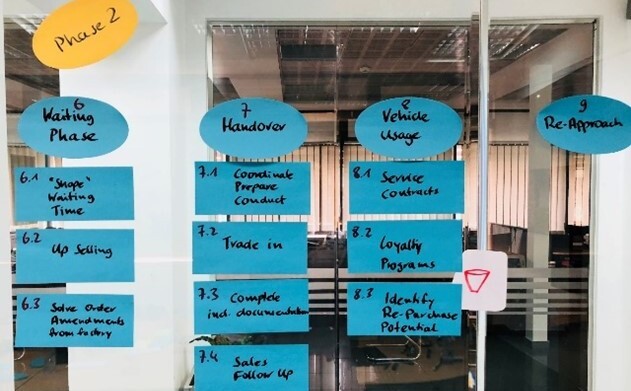
Ján Ferjo, Business Development Director at con4PAS, was there in 2014 when con4PAS was the first to implement SAP Cloud for Customer in Central and Eastern Europe. What is his opinion on Cloud projects in customer management given his many years of experience?
A “Cloud” in computing is no longer an alien concept familiar only to a few insiders. It has become an integral part of our lives, both personal and corporate. A lot of applications now run in the Cloud, and I think that there is no software vendor on the market that does not run a substantial part of its applications in the Cloud. SAP’s application environment is no exception. In this article I briefly summarise my experience with deploying Cloud solutions in customer relations management – CRM.
con4PAS has been on the market since 2003 and since its establishment, the company has focused primarily on customer (CRM) and supplier management solutions on the SAP platform. In 2014, when the first versions of SAP Cloud for Customer for Central and Eastern Europe were released, con4PAS started gaining experience with Cloud CRM solutions. At the same time, SAP started to create local structures to support the solution in individual markets. Given the nature of its business, con4PAS became interested in this new solution.
The principles of CRM are very similar for on-prem and Cloud solutions. Looking back, I have to say that the fact that we already had a CRM team at con4PAS (and especially its process know-how) gave our company a relatively good head start in adapting this new approach and reduced its overall internal costs. So, at the time when the rest of the market was just reading about Cloud solutions in professional articles, at con4PAS we were already “playing” with the first version of the solution and trying to bring it to life and integrate it with our internal ERP system. It was anticipated that a key success factor for the implementation would be, as with the on-prem solution, the integration of the Cloud solution into the existing ERP.
The year 2015 was a turning point, as the efforts of con4PAS were transformed into actual business cases that resulted in the first implementations. I would like to highlight, for example, the implementation for CERVA, as it was the first project for an international sales team reaching beyond the borders of the Czech Republic.
The first completed project, the first joint presentation, the first conference – things took off quickly from there. We found ourselves on a plane to the Middle East on our way to present our experience to the multinational company alfanar, which eventually decided to establish co-operation with us, which continues to this day. This marked the beginning of dynamic development of Cloud projects in various sectors, from automotive to utilities to retail and wholesale. The total number of Cloud projects of con4PAS in 2021 exceeded 20.


Although Cloud projects are diverse and each of them has its own specifics, e.g., in terms of processes or prioritisation of objectives, they share two basic premises:
When transforming business, service or marketing processes, a Cloud platform is automatically considered a step forward. The exceptions that still exist stem from the territoriality of the solution and the legislation of the country concerned, and mainly include projects for public administration.
Integration is the number one issue for any customer using an SAP ERP (SAP S/4HANA) solution. This fact, which is sometimes underestimated, plays an important role in the use of a given system, whether for business or service purposes. In sales, one needs financial data to operate properly. A service provider needs, e.g., the type of service agreement from which the warranty is derived. Today, most companies record such data in the already mentioned ERP.
If I am to summarise and generalise conclusions from implemented cloud projects, I must start with the expectations that each company has from the deployment of a CRM solution. Although their expectations are diverse, like the premises described above, they usually fall into three basic categories:
One of the main objectives, only differently expressed each time, is the creation of a single platform within the group/team (e.g., domestic/foreign trade) or beyond the group (e.g., trade and service, or marketing and trade). This goal is very often influenced by the size of the company, with a certain inverse relationship – the larger the company, the smaller the process scope of the initial deployment (e.g., only sales or marketing processes). In multinational companies, this is mainly due to the greater diversification of teams whose priorities may differ at any given time and whose consolidation is time-consuming and directly conflicts with the requirement for rapid deployment of the solution in question. At the same time, however, this does not rule out the existence of a more global development plan for individual solutions that corresponds to the company’s overall business strategy.
The requirement for a unified system of reporting, recording and evaluating sales, service and marketing activities is a critical parameter in today’s online team communication. From a management perspective, this is a logical requirement that helps in deciding on the next course of action.
While I list this requirement last, it is becoming critical for most companies in today’s digital age. In particular, companies whose activities reach beyond the borders of one country and whose activities depend on the current epidemiological situation in their area of interest put a greater emphasis on it.
Compared to the expectations already discussed, which can easily be classified into the three areas mentioned above, the initial situation varies considerably from company to company. However, even in this case I can define what they have in common:
From the number of projects already implemented, we can derive a number of parameters that can serve as inputs for the business cases of companies considering the solution. Here I would like to draw on a study by Forrester Research, which works with a far larger implementation base and whose results correspond with our project outputs:
The Forrester Research study is available on SAP’s website.
The implementing partner plays a key role in the journey from expectations to the achievement of the described objectives and must have considerable know-how in the field of “business/process consulting”. This partner role is not new and was already necessary during the implementation of on-prem solutions. However, Cloud solutions have introduced one essential dimension that must be considered in the process – the degree of possible customisation provided by the Cloud solution. While on-prem solutions allow for any customisation by the very nature of their implementation, Cloud solutions have their own specific features that need to be taken into account. I would like to dispel the persistent myth that Cloud solutions are rigid and do not allow any deviations from the standard. An example is the aforementioned implementation at our customer alfanar, where the degree of customisation was very high, while taking into account all the development standards that are associated with such changes.
One of the ways of turning expectations into clearly defined goals is to use the process of design thinking, which aims to jointly design a final process map that takes into account the specifics already mentioned. The output can be a set of processes created using visualisation (see photos).
 |
 |
As in on-prem projects, early evaluation of basic parameters in terms of risk significantly influences the adoption rate of the delivered Cloud solution across the company structure:
In the current scarcity of both manufacturing and human resources, efficient use of available technology is a key factor in a company’s success on the market. From a human resources perspective, given their availability and turnover rates, information about the history of the relationship with a given customer is an indispensable benefit for any company, just as it was before the outbreak of the COVID-19 pandemic. However, this pandemic has introduced another essential parameter, namely the shortage of production resources, which has caused demand to exceed supply. Proper evaluation of all available information about the customer (payment morale, joint history, progress of co-operation, etc.) should form the basis of decision-making at every managerial level from strategic to operational, and a properly set-up system supporting these processes brings a competitive advantage in this currently dynamically changing market.
![]()
Interested in the article and want to know more? |
Read more about the solutions in Customer Management line of business and their respective success stories.
SAP C4C Intelligent Sales Add-On Dynamic Visit Planning Add-On Service Agent Console Add-On SAP CPQ SAP CRM Sinch Contact Pro

